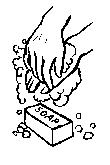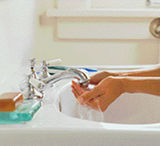

Introduction
Studies have shown that handwashing is the single most important thing people can do to prevent the spread of germs. However, a recent survey of people's handwashing habits conducted in public restrooms across the United States found that almost one third of people do not wash their hands after using the bathroom.
In a recent school-based handwashing study, students were required in school to wash their hands thoroughly four times each day. They washed their hands upon arrival at school, before lunch, after using the restroom, and before leaving school for home. The result was predictable: Absenteeism in the school decreased sharply during the study period.
Never assume that children know how to wash their hands. They need to be taught to use soap and warm, running water; to wash all surfaces thoroughly, including wrists, palms, back of hands, fingers, and under the fingernails; and to rub their hands together for at least 10 to 15 seconds.
Everyone should wash their hands before they prepare or eat food, before they treat a cut or wound, and before they take care of someone who is sick.
Everyone should wash their hands after they handle uncooked foods, especially raw meat, poultry, or fish. They should also wash after using the restroom, playing with a pet (especially reptiles and exotic animals), blowing their nose or coughing or sneezing, changing a diaper, handling garbage, or taking care of someone who is sick.
Handwashing may seem trivial, but the spread of many germs that cause infections, ranging from the common cold to diarrhea, can be reduced by handwashing with soap and water.

PROPER HANDWASHING
Proper handwashing is the MOST effective way to prevent the spread
of germs!
How to do it:
1. Roll down the paper towel.
2. Wash your hands for 30 seconds
(sing the happy birthday song) with soap
and warm water; don't forget your thumbs
and between your fingers!
3. Grab the paper towel to
dry your hands,
then use it to turn off the faucet.
4. The paper towel may now
be used to open
the door to leave the restroom (if there is
a door), and discarded in the trash container
on your way out.

Graphic source from "University of Hawaii CTAHR-Cooperative Extension Service"
Disclaimer: This information is not intended be a substitute for professional medical advice. It is provided for educational purposes only. You assume full responsibility for how you choose to use this information.
Click on these websites for additional information.
Clean Hands Coalition
http://www.cleanhandscoalition.org
Partnership for Food Safety Education